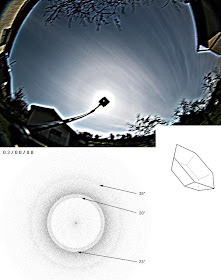
The April 21st 2007 was undoubtely one of the best halo days in this year. Observers from all over the Czech Republic enjoyed very bright 22° halo with tangent arcs and infralateral arcs.
We probably observed Wegener arcs and 120° parhelia, but this cannot be proven, because even fotos from Registax didn’t help us to clearly identify them. Anyway, Martin Popek saw that day very nice 46° halo and he took these pictures which were stacked from 40 images in Registax.
As the Sun was setting down, more halos appeared. In the second picture you can see parhelion with a part of parhelic circle (parhelic tail), 22° halo, circumzenithal arc and probably supralateral arc.
Edit: It isn’t supralateral arc in the second photo, but 46° halo because there is no upper tangent arc. That signifies absence of horizontal oriented columns, which are necessary in order to make supralateral arc.




